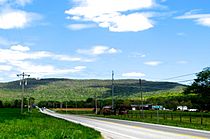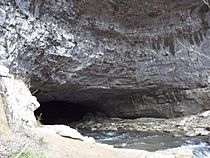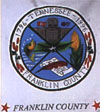Franklin County, Tennessee facts for kids
Quick facts for kids
Franklin County
|
|||
|---|---|---|---|

Franklin County Courthouse in Winchester
|
|||
|
|||

Location within the U.S. state of Tennessee
|
|||
 Tennessee's location within the U.S. |
|||
| Country | |||
| State | |||
| Founded | 1807 | ||
| Named for | Benjamin Franklin | ||
| Seat | Winchester | ||
| Largest city | Winchester | ||
| Area | |||
| • Total | 576 sq mi (1,490 km2) | ||
| • Land | 555 sq mi (1,440 km2) | ||
| • Water | 21 sq mi (50 km2) 3.7%% | ||
| Population
(2020)
|
|||
| • Total | 42,774 |
||
| • Density | 74/sq mi (29/km2) | ||
| Time zone | UTC−6 (Central) | ||
| • Summer (DST) | UTC−5 (CDT) | ||
| Congressional district | 4th | ||
Franklin County is a special area in the U.S. state of Tennessee. It is called a county. You can find it in the southern part of Tennessee, on the eastern edge of Middle Tennessee.
In 2020, about 42,774 people lived here. The main town, or county seat, is Winchester. Franklin County used to be part of a larger area. Now, it is part of the Winchester Micropolitan Statistical Area.
Contents
History of Franklin County
People from Europe started settling here around the year 1800. Franklin County was officially created in 1807. It was named after Benjamin Franklin, a famous American leader.
Over the years, the county's size changed. Parts of it were used to create nearby counties. These included Coffee County, Moore County, and Grundy County.
A famous frontiersman named Davy Crockett came to the area around 1812. He was an early settler, but he did not stay for a long time.
Education and War Times
The University of the South was started here. It was founded by the Episcopal Church just before the Civil War. The university fully opened after the war ended. It includes a university and a special school for religious studies. The University of Tennessee Space Institute is also in Franklin County.
Before the Civil War, many people in the area wanted to leave the United States. Franklin County even said it would join Alabama if Tennessee did not leave the Union. Tennessee did leave the Union when President Abraham Lincoln asked states to choose sides. This was different from Winston County, Alabama, which supported the Union.
During 1863, the Confederate Army of Tennessee moved through the county. After this, the Union army mostly controlled the area. However, some small groups still fought. Isham G. Harris, who was the Confederate governor of Tennessee, was from Franklin County. After the war, he became a Senator for Tennessee.
Changes in the 20th Century
In the late 1800s, there was a movement to stop the sale of alcohol. This was called the temperance movement. People found a strange rule in state law. It said alcohol could only be sold in towns that had official city governments. So, all the towns in Franklin County gave up their official city governments. This way, they could stop alcohol from being sold.
In the 1900s, Franklin County got help from the Tennessee Valley Authority (TVA). The TVA was a government project built during the Great Depression. It helped control floods and make electricity. The TVA brought new jobs and industries to the area. It also created new lakes for fun activities. But, it also meant some people had to move from their homes.
The Arnold Engineering Development Center was also built here. This federal center helped the county grow with new technology. The interstate highway system, especially Interstate 24, also helped. It made it easier to get to nearby Chattanooga.
Important People and Rights
Two famous people were born in Franklin County in the early 1900s. One was Dinah Shore, a singer and entertainer. The other was John Templeton, a successful businessman and giver of money. He later became a British citizen and was made a knight.
In the late 1800s and early 1900s, Tennessee had Jim Crow laws. These laws created racial segregation in public places. They also made it harder for Black people to vote. Franklin County did not have as much violence as some other places. But, its schools were not desegregated until 1964. This happened after a lawsuit was won at Sewanee, Tennessee.
In the last part of the 1900s, more industries came to the county. This included a large car engine factory built by Nissan in Decherd. Tourism also became important. People visit for Civil War history and beautiful places. The county is known for its dogwood forests. An annual festival celebrates these trees.
Geography of Franklin County



Franklin County covers about 576 square miles (1,492 square kilometers). Most of this is land, about 555 square miles (1,437 square kilometers). The rest, about 21 square miles (54 square kilometers), is water.
The county is on the border with Alabama. It has many different types of land. It goes from the low areas of the Nashville Basin up to the Cumberland Plateau. This means the elevation changes by about 1,300 feet (396 meters).
The county has many forests and is well-watered. Most areas are good for farming. It has a long growing season and mild winters.
Natural Wonders
Sewanee Natural Bridge is a natural rock arch. It is about 25 feet (7.6 meters) high. The arch itself spans about 50 feet (15 meters).
Lost Cove Cave is near Sherwood. It is part of the Carter State Natural Area. One entrance is called Buggytop Cave Entrance. It is 100 feet (30 meters) wide and 80 feet (24 meters) high. A stream flows out of the cave and drops 40 feet (12 meters) in less than 100 yards (91 meters).
Neighboring Counties
- Coffee County (north)
- Grundy County (northeast)
- Marion County (east)
- Jackson County, Alabama (south)
- Madison County, Alabama (southwest)
- Lincoln County (west)
- Moore County (northwest)
Protected Natural Areas
Franklin County has several state protected areas. These places help keep nature safe.
- Bear Hollow Wildlife Management Area
- Carter State Natural Area
- Franklin State Forest (part)
- Hawkins Cove State Natural Area
- Mingo Swamp Wildlife Management Area
- Natural Bridge State Natural Area
- Owl Hollow Mill Wildlife Management Area
- South Cumberland State Park (part)
- Tims Ford State Park
- Walls of Jericho State Natural Area
Other Water Areas
Population Changes Over Time
| Historical population | |||
|---|---|---|---|
| Census | Pop. | %± | |
| 1810 | 5,730 | — | |
| 1820 | 16,571 | 189.2% | |
| 1830 | 15,620 | −5.7% | |
| 1840 | 12,033 | −23.0% | |
| 1850 | 13,768 | 14.4% | |
| 1860 | 13,848 | 0.6% | |
| 1870 | 14,970 | 8.1% | |
| 1880 | 17,178 | 14.7% | |
| 1890 | 18,929 | 10.2% | |
| 1900 | 20,392 | 7.7% | |
| 1910 | 20,491 | 0.5% | |
| 1920 | 20,641 | 0.7% | |
| 1930 | 21,796 | 5.6% | |
| 1940 | 23,892 | 9.6% | |
| 1950 | 25,431 | 6.4% | |
| 1960 | 25,528 | 0.4% | |
| 1970 | 27,244 | 6.7% | |
| 1980 | 31,983 | 17.4% | |
| 1990 | 34,725 | 8.6% | |
| 2000 | 39,270 | 13.1% | |
| 2010 | 41,052 | 4.5% | |
| 2020 | 42,774 | 4.2% | |
| U.S. Decennial Census 1790-1960 1900-1990 1990-2000 2010-2014 |
|||
The population of Franklin County has grown a lot since 1810. In 1810, there were 5,730 people. By 2020, the population had reached 42,774. This shows how the county has developed over many years.
Communities in Franklin County
Franklin County has several towns and cities. Here are some of them:
Cities
- Cowan
- Decherd
- Tullahoma (partly in this county)
- Winchester (This is the county seat)
Towns
- Estill Springs
- Huntland
- Monteagle (also in Marion and Grundy Counties)
Census-designated place
Other Communities
These are smaller places that are not officially cities or towns.
- Alto
- Asia
- Beech Hill
- Belvidere
- Broadview
- Midway
- Shady Grove
- Sherwood
Notable People from Franklin County
Many interesting people have come from Franklin County.
- Stephen Adams (1807–1857), a former U.S. Senator and Representative.
- James Patton Anderson, (1822–1873), a general in the Confederate Army.
- Jimmy Bedford (1940–2009), who was the sixth master distiller at Jack Daniel's.
- Phillip Fulmer (born 1950), a former head coach for the Tennessee Volunteers football team.
- Jauan Jennings (born 1997), a Wide Receiver for the San Francisco 49ers.
- Shirley Majors (1913-1981), a former head coach for The Sewanee Tigers football team.
- Bernie Moore (1895–1967), who was a commissioner for the Southeastern Conference.
- Dinah Shore (1916–1994), a famous singer, actress, and TV star.
- John Templeton (1912–2008), a well-known investor and giver of money.
See also
 In Spanish: Condado de Franklin (Tennessee) para niños
In Spanish: Condado de Franklin (Tennessee) para niños




